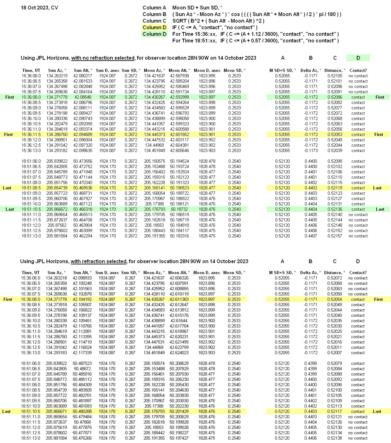
NavList:
A Community Devoted to the Preservation and Practice of Celestial Navigation and Other Methods of Traditional Wayfinding
From: Chuck Varney
Date: 2023 Oct 18, 21:11 -0700
Kermit,
As you covered earlier, I posted these first and last contact times using JPL Horizons data:
No refraction selected
15:36:11.5 UT - first contact
18:51:08.5 UT - last contact
With refraction selected
15:36:08.0 UT - first contact
18:51:10.5 UT - last contact
These are shown in the yellow highlighted lines in the attachment.
In an attempt to remove from the ‘No refraction’ case the effect of contraction of body angular dimension due to refraction that Horizons apparently uses for both the refracted and non-refracted cases, I added small angles to the sum of the Sun and Moon semidiameters.
I found by experiment that the ‘No refraction’ first and last contact times could be made equal to those of the ‘With refraction’ case by adding as little as 1.12” to the sum of the Sun and Moon semidiameters for the 15:36:xx time block entries and 0.57” to the sum of Sun and Moon semidiameters for 18:51:xx time block entries. The green highlighted areas in the attachment relate to these changes.
I also experimented with adding the same angle to both time blocks. Several examples follow.
Added angle = 1.12”
15:36:08.0 UT - first contact
18:51:12.0 UT - last contact
Added angle = 1.2”
15:36:08.0 UT - first contact
18:51:12.5 UT - last contact
Added angle = 1.0”
15:36:08.5 UT - first contact
18:51:11.5 UT - last contact
Bear in mind that these results were obtained using JPL Horizons’ minimum time increment of 0.5 second.
Chuck V.







